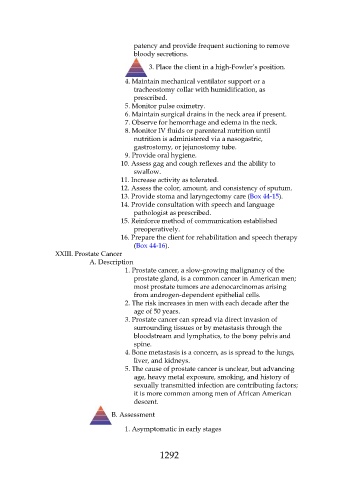Page 1292 - Saunders Comprehensive Review For NCLEX-RN
P. 1292
patency and provide frequent suctioning to remove
bloody secretions.
3. Place the client in a high-Fowler’s position.
4. Maintain mechanical ventilator support or a
tracheostomy collar with humidification, as
prescribed.
5. Monitor pulse oximetry.
6. Maintain surgical drains in the neck area if present.
7. Observe for hemorrhage and edema in the neck.
8. Monitor IV fluids or parenteral nutrition until
nutrition is administered via a nasogastric,
gastrostomy, or jejunostomy tube.
9. Provide oral hygiene.
10. Assess gag and cough reflexes and the ability to
swallow.
11. Increase activity as tolerated.
12. Assess the color, amount, and consistency of sputum.
13. Provide stoma and laryngectomy care (Box 44-15).
14. Provide consultation with speech and language
pathologist as prescribed.
15. Reinforce method of communication established
preoperatively.
16. Prepare the client for rehabilitation and speech therapy
(Box 44-16).
XXIII. Prostate Cancer
A. Description
1. Prostate cancer, a slow-growing malignancy of the
prostate gland, is a common cancer in American men;
most prostate tumors are adenocarcinomas arising
from androgen-dependent epithelial cells.
2. The risk increases in men with each decade after the
age of 50 years.
3. Prostate cancer can spread via direct invasion of
surrounding tissues or by metastasis through the
bloodstream and lymphatics, to the bony pelvis and
spine.
4. Bone metastasis is a concern, as is spread to the lungs,
liver, and kidneys.
5. The cause of prostate cancer is unclear, but advancing
age, heavy metal exposure, smoking, and history of
sexually transmitted infection are contributing factors;
it is more common among men of African American
descent.
B. Assessment
1. Asymptomatic in early stages
1292

